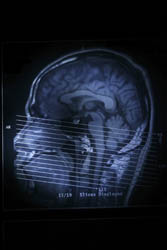Innovative solutions for brain imaging
Computed tomography (CT), magnetic resonance imaging (MRI) and positron emission tomography (PET) are imaging techniques that provide extensive anatomical and physiological data of outmost importance for guiding diagnosis and therapy in clinical practice. However, these methods cannot assess systemic parameters such as heart rate or blood pressure, and they cannot they be applied at the bedside. Electroencephalography (EEG) constitutes a long-standing technique that can continuously and non-invasively monitor the brain. The EU-funded 'Non-invasive imaging of brain function and disease by pulsed near infrared light' (NEUROPT) consortium was motivated to generate a clinical tool for continuous monitoring of the haemodynamic parameters of cerebral oxygenation and perfusion. This tool should also complement MRI/CT/PET methods and at the same time be compatible with existing neuro-monitoring techniques (EEG, Doppler ultrasound). To achieve this, partners had to improve spatial resolution of current imaging techniques, remove artefacts and enable the absolute quantification of physiological parameters. To this end, they employed time-resolved techniques that offer greater sensitivity than most optical methods and distinguish between surface tissues (e.g. skin and skull) and brain tissue. Novel photonic devices were constructed as well as device prototypes for use in the clinical setting, including a specialised helmet for attaching the optical fibres to the head. Through software development, researchers could also analyse the time-resolved measurements on the head and calculate the oxy- and deoxyhaemoglobin concentrations. Additionally, NEUROPT researchers worked on realistic modelling and computation, especially with a view to improving light propagation in the human head. The feasibility of this combinatorial approach was tested in separate visual and motor studies in healthy individuals. It was further successfully applied to perform measurements in patients with acute neurological conditions, photosensitive epilepsy or stroke. Given the non-invasive nature of the NEUROPT approach and its potential to be continuously applied at the bedside, it should facilitate the diagnosis of functional brain impairment and monitor its progress. As a result, it should improve the prognosis of patients with serious neurological conditions and could also be applied for imaging the brains of infants.

